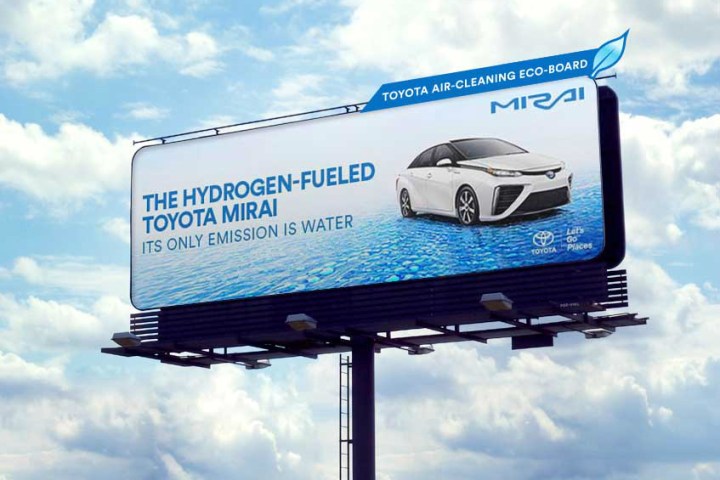
The Toyota Mirai eco-billboard campaign, working in conjunction with Clear Channel Outdoor Americas, will launch 37 billboards in Los Angeles and San Francisco. From April 3 to May 28, these structures will create 24,960 square feet of pollution-scrubbing surface, and reverse the nitrogen dioxide (NOx) emissions of an equivalent 5,285 vehicles per month, according to a Toyota press release. NOx is a contributor to acid rain and smog.
The billboards operate something like a catalytic converter with titanium dioxide-coated vinyl to clean the air. Oxygen reacts with the energized titanium dioxide catalyst, and NOx is converted to nitrate and removed from the air. The billboards are light-activated and will continue to purify the air as long as light, humidity, airflow, and the titanium dioxide coating are present.
“Toyota consistently searches for new environmental technologies across all operations,” Mark Angelacos, advanced technology general manager, Toyota Motor North America, said. “When Clear Channel Outdoor Americas brought us the opportunity, we saw it as a perfect match. This new campaign delivers Toyota Mirai’s ‘vehicle of change’ message on a medium that lives up to that promise.”
The titanium dioxide coating technology used on the eco-billboards was developed by the PURETi Group, and Clear Channel Outdoor Americas has exclusive usage rights in the outdoor advertising category.
“We are pleased to offer our environmentally conscious clients, like Toyota, an even more eco-friendly printed vinyl option for their Out-of-Home (OOH) media campaigns,” Gene Leehan, executive vice president and senior regional president, Clear Channel Outdoor Americas, said. “This campaign marks a U.S. first for the use of this technology on OOH, and we look forward to making it available to other like-minded advertisers.”
The eco-billboard campaign was highlighted during the first Environmental Media Association Impact Summit in Beverly Hills, California. A Mirai was wrapped with the titanium dioxide coated vinyl, and it purified the air as guests entered the event.
Editors' Recommendations
- Toyota joins ‘the Tesla plug’ club
- 2023 Toyota Sequoia supersizes hybrid tech
- 2022 Toyota GR 86 first drive: Old-school thrills meet modern tech
- Toyota RAV4 vs. Honda CR-V: The differences and the similarities
- 2021 Toyota Prius vs. 2021 Toyota Prius Prime


